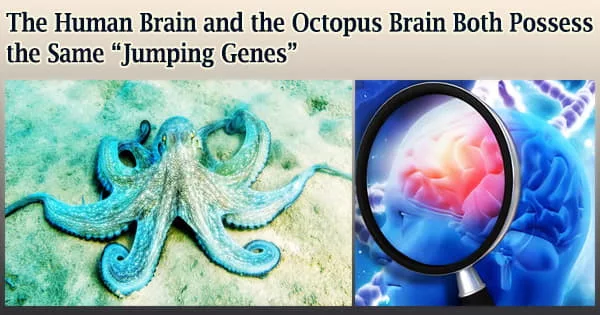The octopus is a remarkable creature with incredible brain complexity and cognitive abilities that are unmatched by other invertebrates. So much so that it resembles vertebrates in certain ways more than it does invertebrates.
According to a study recently published in BMC Biology and organized by Remo Sanges from SISSA in Trieste and Graziano Fiorito from Stazione Zoologica Anton Dohrn in Naples, the neurological and cognitive complexity of these creatures may have evolved from a molecular analogy with the human brain.
The study demonstrates that the same “jumping genes” are active in the brains of two different species, the common octopus Octopus vulgaris, and the Californian octopus Octopus bimaculoides. a finding that might shed light on the mystery of these remarkable critters’ intellect.
Molecular copy-and-paste or cut-and-paste mechanisms allow transposons, often known as “jumping genes,” to ‘move’ from one location to another in an individual’s genome, shuffling or duplicating, as early as 2001’s sequencing of the human genome showed.
Most of the time, these moving parts are silent since they no longer move and have no observable impact. Some have become dormant as a result of generations’ worth of mutations, while others are unaltered but obstructed by cellular defensive mechanisms.
Even these damaged copies of transposons and their fragments can still be helpful from an evolutionary standpoint because they are considered to be “raw stuff” that evolution can shape.
The brain of the octopus is functionally analogous in many of its characteristics to that of mammals. For this reason, also, the identified LINE element represents a very interesting candidate to study to improve our knowledge on the evolution of intelligence.
Graziano Fiorito
The most significant of these mobile elements are those from the so-called LINE (Long Interspersed Nuclear Elements) family, which is present in the human genome in 100 copies and is still possibly active.
Although it has long been believed that the activity of LINEs is only a relic of the past, a byproduct of the evolutionary processes that involved these mobile elements, recent research has revealed that LINE activity is tightly controlled in the brain.
Many scientists think that LINE transposons are connected to cognitive functions like learning and memory because they are particularly active in the hippocampus, which is crucial for the neuronal control of learning processes in human brains.
Like our genome, that of the octopus is filled with “jumping genes,” most of which are dormant. The researchers discovered a component of the LINE family in regions of the brain that are essential for these animals’ cognitive capacities by concentrating on the transposons still capable of copy-and-paste.
The discovery was made possible by next-generation sequencing techniques, which were used to examine the molecular makeup of the genes active in the octopus nervous system. It was the result of a collaboration between Scuola Internazionale Superiore di Studi Avanzati, Stazione Zoologica Anton Dohrn, and Istituto Italiano di Tecnologia.
“The discovery of an element of the LINE family, active in the brain of the two octopuses species, is very significant because it adds support to the idea that these elements have a specific function that goes beyond copy-and-paste,” explains Remo Sanges, director of the Computational Genomics Laboratory at SISSA, who started working at this project when he was a researcher at Stazione Zoologica Anton Dohrn of Naples.
The study, which was conducted by a global team of more than twenty researchers from different countries, was published in BMC Biology.
“I literally jumped on the chair when, under the microscope, I saw a very strong signal of activity of this element in the vertical lobe, the structure of the brain which in the octopus is the seat of learning and cognitive abilities, just like thehippocampus in humans,” tells Giovanna Ponte from Stazione Zoologica Anton Dohrn.
According to Giuseppe Petrosino from Stazione Zoologica Anton Dohrn and Stefano Gustincich from Istituto Italiano di Tecnologia, “This similarity between man and octopus that shows the activity of a LINE element in the seat of cognitive abilities could be explained as a fascinating example of convergent evolution, a phenomenon for which, in two genetically distant species, the same molecular process develops independently, in response to similar needs.”
“The brain of the octopus is functionally analogous in many of its characteristics to that of mammals,” says Graziano Fiorito, director of the Department of Biology and Evolution of Marine Organisms of the Stazione Zoologica Anton Dohrn. “For this reason, also, the identified LINE element represents a very interesting candidate to study to improve our knowledge on the evolution of intelligence.”
















